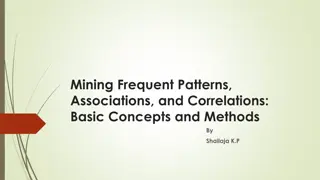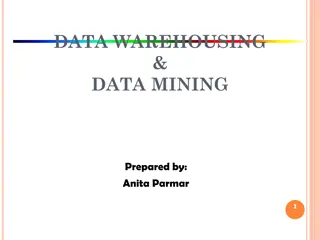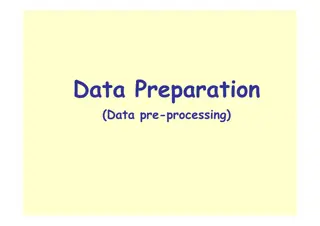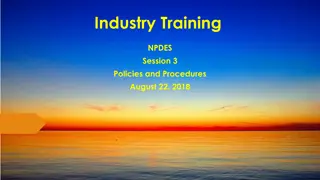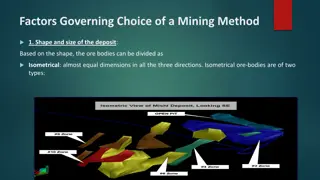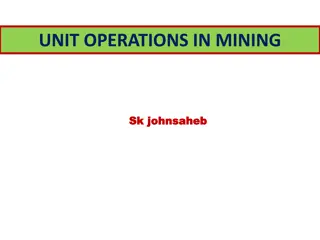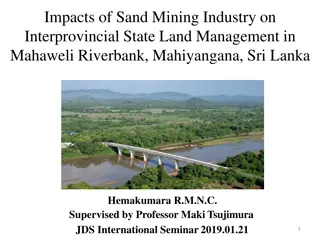
Spatial Data Management Insights
Explore trajectory data mining, management, spatial queries, indexing structures, and more in this comprehensive overview. Learn about key concepts such as trajectory classification, distance metrics, spatial databases, and spatial indexing structures like R-Tree and Quad-tree.
Download Presentation

Please find below an Image/Link to download the presentation.
The content on the website is provided AS IS for your information and personal use only. It may not be sold, licensed, or shared on other websites without obtaining consent from the author. If you encounter any issues during the download, it is possible that the publisher has removed the file from their server.
You are allowed to download the files provided on this website for personal or commercial use, subject to the condition that they are used lawfully. All files are the property of their respective owners.
The content on the website is provided AS IS for your information and personal use only. It may not be sold, licensed, or shared on other websites without obtaining consent from the author.
E N D
Presentation Transcript
Trajectory Data Mining Dr. Yu Zheng Lead Researcher, Microsoft Research Chair Professor at Shanghai Jiao Tong University Editor-in-Chief of ACM Trans. Intelligent Systems and Technology http://research.microsoft.com/en-us/people/yuzheng/
Paradigm of Trajectory Data Mining Uncertainty Traj. Pattern Mining Trajectory Classification Graph Mining Moving Together Patterns Clustering Privacy Preserving Freq. Seq. Patterns Trajectory Outlier/Anomaly Detection Periodic Patterns Reducing Uncertainty Routing Trajectory Indexing and Retrieval Distance of Trajectory Matrix Analysis Query Historical Trajectories Managing Recent Trajectories TD MF Trajectory Preprocessing Map-Matching Compression CF Stay Point Detection Noise Filtering Segmentation Matrix Spatial Trajectories Spatial Trajectories Spatial Trajectories Tensor Graph Yu Zheng. Trajectory Data Mining: An Overview. ACM Transactions on Intelligent Systems and Technology. 2015, vol. 6, issue 3.
Trajectory Data Management Spatial Databases Queries Range queries KNN queries Distance metrics The distance between a point ? and a trajectory The Distance between two trajectories The distance between two trajectory segments Indexing structures Retrieval algorithms qt Tr3 Tr3 Tr3 q1 R Tr2 Tr2 Tr2 p2 q2Tr1 Tr1 Tr1 A) Range Query B) KNN Point Query C) KNN Trajectory Query Segment 3 time Time slot 0 Time slot 1 Tr1 Segment 2 Segment 1 x y B) A spatial index in each time slot C) A temporal index A) 3DR-Tree
Trajectory Data Management Spatial Databases Queries Range queries KNN queries Distance metrics The distance between a point ? and a trajectory The Distance between two trajectories The distance between two trajectory segments Indexing structures Retrieval algorithms
Spatial Queries Nearest Neighbour Queries Region (Range) Query Given a point or an object, find the nearest object that satisfies given conditions Ask for objects that lie partially or fully inside a specified region.
Spatial Indexing Structures Space Partition-Based Indexing Structures Grid-based Quad-tree k-D tree Data-Driven Indexing Structures R-Tree
Spatial Indexing Structures Space Partition-Based Indexing Structures Grid-based Quad-tree k-D tree Data-Driven Indexing Structures R-Tree
Grid-based Spatial Indexing Indexing Partition the space into disjoint and uniform grids Build inverted index between each grid and the points in the grid g2 g1 g1 p1 p3 p1 p4 p3 g2 p4
Grid-based Spatial Indexing Range Query Find the girds intersecting the range query Retrieve the points from the grids and identify the points in the range g1 p2 p4 g2 p3 p4 p2 g3 p1 p3 g4 p1
Grid-based Spatial Indexing Nearest neighbor query Euclidian distance Road network distance is quite different The nearest object is within the grid The nearest object is outside the grid Fast approximation p2 p2 p1 p1 p1
Grid-based Spatial Indexing Advantages Easy to implement and understand Very efficient for processing range and nearest queries Disadvantages Index size could be big Difficult to deal with unbalanced data
Quad-Tree Indexing Each node of a quad-tree is associated with a rectangular region of space; the top node is associated with the entire target space. Each non-leaf node divides its region into four equal sized quadrants Leaf nodes have between zero and some fixed maximum number of points (set to 1 in example). 00 0 1 0 2 1 3 03 02 30 00 30 31 2 3 33 32 12
Quad-Tree Range query 00 0 1 0 1 2 3 03 02 20 23 30 31 2 3 33 32
Quad-Tree Nearest Neighbour Query (hard) 00 0 1 0 1 2 3 03 02 20 23 30 31 2 3 33 32
K-D-Tree Each line in the figure (other than the outside box) corresponds to a node in the k-d tree the maximum number of points in a leaf node has been set to 1. The numbering of the lines in the figure indicates the level of the tree at which the corresponding node appears. 15
K-D-Tree Example X=7 X=5 y=6 y=5 Y=6 x=8 x=7 x=3 Y=5 y=2 Y=2 X=5 X=8 X=3
K-D-Tree Example Range query X=5 X=7 Q=(4,7), (7,5) X=3 y=6 y=5 x=8 x=7 x=3 Y=6 Y=5 y=2 Y=2 X=5 X=8
K-D-Tree Nearest neighbor query
Spatial Indexing Structures Space Partition-Based Indexing Structures Grid-based Quad-tree k-D tree Data-Driven Indexing Structures R-Tree
R-Trees Build a Minimum Bounding Rectangle (MBR) MBR = {(L.x,L.y)(U.x,U.y)} Note that we only need two points to describe an MBR, we typically use lower left, and upper right.
R-Trees We can group clusters of data points into MBRs Can also handle line-segments, rectangles, polygons, in addition to points R1 R4 We can further recursively group MBRs into larger MBRs . R2 R5 R3 R6 R9 R7 R8
R-Tree Structure Nested MBRs are organized as a tree R10 R11 R10 R11 R12 R1 R2 R3 R4 R5 R6 R7 R8 R9 R12 Data nodes containing points
Nearest Neighbour Search Given an MBR, we can compute lower bounds on nearest object Once we know there IS an item within some distance d, we can prune away all items/MBRs at distance > d Even if we haven t actually found the nearest item yet Similar technique possible for k-d trees and quad-trees as well Q R10 R11 R10 R11 R12 R1 R2 R3 R4 R5 R6 R7 R8 R9 R12 Data nodes containing points
Comparison among Spatial Indices Unbalanced data Range query Nearest neighbor Construc tion Balanced structure Storage Grid-based Poor Good Nomal Easy Yes Big Quad-Tree Good Best Poor Easy No Median KD-Tree Good Normal Good Easy Almost Median R-Tree Good Normal Best Difficult Yes Small
Trajectory Data Management Spatial Databases Queries Range queries KNN queries Distance metrics The distance between a point ? and a trajectory The Distance between two trajectories The distance between two trajectory segments Indexing structures Retrieval algorithms qt Tr3 Tr3 Tr3 q1 R Tr2 Tr2 Tr2 p2 q2Tr1 Tr1 Tr1 A) Range Query B) KNN Point Query C) KNN Trajectory Query Segment 3 time Time slot 0 Time slot 1 Tr1 Segment 2 Segment 1 x y B) A spatial index in each time slot C) A temporal index A) 3DR-Tree
Trajectory Data Management Range queries E.g. Retrieve the trajectories of vehicles passing a given rectangular region R between 2pm-4pm in the past month qt Tr3 Tr3 Tr3 q1 R Tr2 Tr2 Tr2 p2 q2Tr1 Tr1 Tr1 A) Range Query B) KNN Point Query C) KNN Trajectory Query KNN queries E.g. Retrieve the trajectories of people with the minimum aggregated distance to a set of query points Publications: [1][2] for a single point query, [3] for multiple query points qt Tr3 Tr3 Tr3 q1 R Tr2 Tr2 Tr2 p2 q2Tr1 Tr1 Tr1 A) Range Query B) KNN Point Query C) KNN Trajectory Query qt E.g. Retrieve the trajectories of people with the minimum aggregated distance to a query trajectory Publications: Chen et al, SIGMOD05; Vlachos et al, ICDE02; Yi et al, ICDE98. Tr3 Tr3 Tr3 q1 R Tr2 Tr2 Tr2 p2 q2Tr1 Tr1 Tr1 A) Range Query B) KNN Point Query C) KNN Trajectory Query [1] E. Frentzos, et al. Algorithms for nearest neighbor search on moving object trajectories. Geoinformatica, 2007 [2] D. Pfoser, et al. Novel approaches in query processing for moving object trajectories. VLDB, 2000. [3] Zaiben Chen, et al. Searching Trajectories by Locations: An Efficiency Study, SIGMOD 2010
Trajectory Data Management Spatial Databases Queries Range queries KNN queries Distance metrics The distance between a point ? and a trajectory The Distance between two trajectories The distance between two trajectory segments Indexing structures Retrieval algorithms qt Tr3 Tr3 Tr3 q1 R Tr2 Tr2 Tr2 p2 q2Tr1 Tr1 Tr1 A) Range Query B) KNN Point Query C) KNN Trajectory Query Segment 3 time Time slot 0 Time slot 1 Tr1 Segment 2 Segment 1 x y B) A spatial index in each time slot C) A temporal index A) 3DR-Tree
Trajectory Data Management Distance metrics The distance between a point ? and a trajectory using an exponential function to assign a larger contribution to a closer matched pair of points while giving much lower value to those far-away pairs qt ? ?,? = ???? ?? ?,? Tr3 Tr3 Tr3 q1 R ) ?(?,? Tr2 ?(?,?) = ? ?? Tr1 Tr2 Tr2 p2 q2Tr1 Tr1 ) ?(?,? ?(?,?) = C) KNN Trajectory Query ? ?? A) Range Query B) KNN Point Query Zaiben Chen, et al. Searching Trajectories by Locations: An Efficiency Study, SIGMOD 2010
Trajectory Data Management The Distance between two trajectories Closest-Pair Distance: ??? ?,? = ???? ?,? ?? ?,? Sum-of-Pairs Distance : ??? ?,? = ?=1 ? ??,? ? Assume two trajectories have the same length Dynamic Time Wrapping (DTW) distance allow repeating some points as many times as needed to get the best alignment some noise points from a trajectory may cause a big distance between trajectories Not metric: Not satisfy the triangle inequality Longest Common Sub-Sequence (LCSS) skip some noise points when calculating the distance A threshold ? is used to determine whether two points are matched EDR distance A threshold ? is used to determine assign penalties to the gaps between two matched sub-trajectories Is metric: satisfy the triangle inequality ERP distance combine the merits of DTW and EDR ?
Trajectory Data Management The distance between two trajectory segments the Minimum Bounding Rectangle (MBR)-based ( ( ??,??, ? ?,? ?))2+( ??,??, ? ?,? )2 (xu,yu) B2 B2 L2 L2 ? d d ,a ,a L2 (xu,yu) d ??,?? ? ?,? ? ? ?> ?? ??> ? ? 0 ,b (xl,yl) d ,b L1 B1 L1 L1 B1 ( ??,??, ? ?,? ?) = ? ? ?? ?? ? ? (xl,yl) A) MBR Distance B) Trajectory-Hausdorff Distance Trajectory-Hausdorff Distance The aggregate perpendicular distance (? ) The aggregate parallel distance (?//) The angular distance (??) ?????= ?1? + ?2?//+ ?3?? (xu,yu) B2 B2 L2 L2 d d ,a ,a L2 (xu,yu) d ,b (xl,yl) d ,b L1 B1 L1 L1 B1 (xl,yl) A) MBR Distance B) Trajectory-Hausdorff Distance
Trajectory Data Management Spatial Databases Queries Range queries KNN queries Distance metrics The distance between a point ? and a trajectory The Distance between two trajectories The distance between two trajectory segments Indexing structures Retrieval algorithms qt Tr3 Tr3 Tr3 q1 R Tr2 Tr2 Tr2 p2 q2Tr1 Tr1 Tr1 A) Range Query B) KNN Point Query C) KNN Trajectory Query Segment 3 time Time slot 0 Time slot 1 Tr1 Segment 2 Segment 1 x y B) A spatial index in each time slot C) A temporal index A) 3DR-Tree
Trajectory Data Management Segment 3 Indexing structures View temporal as an additional dimension 3D R-Tree ST R-Tree TB-Tree Divides a time period into multiple time intervals a spatial index in each interval HR-tree MR-tree HR+-tree MV3R-tree Partition a geographical space into grids a temporal index in each grid CSE-Tree x time Time slot 0 Time slot 1 Tr1 Segment 2 Segment 1 x y B) A spatial index in each time slot C) A temporal index A) 3DR-Tree Segment 3 time Time slot 0 Time slot 1 Tr1 Segment 2 Segment 1 x y B) A spatial index in each time slot C) A temporal index Segment 3 A) 3DR-Tree Time slot 1 time Time slot 0 Tr1 Segment 2 Segment 1 y B) A spatial index in each time slot C) A temporal index A) 3DR-Tree
Trajectory Data Management R-Tree R10 R11 R10 R11 R12 R1 R2 R3 R4 R5 R6 R7 R8 R9 R12 Data nodes containing points
Trajectory Data Management 3D R-tree Time y x
Trajectory Data Management Multi-version R-tree (HR-tree [Tao2001a], HR+-tree[Tao2001b], MR-tree[Xu2005]) For each timestamp, an R-tree is created. So, there are many R-trees. These R-trees are indexed. HR-tree [Tao2001] Query for trajectories in a given region and in a given time interval: 1. The R-tree at the timestamp is found first 2. The trajectories in the specified region are retrieved from the R-tree.
CSE-Tree Problem Definition Retrieve the GPS trajectories across a given region and intersecting a given time span Present techniques are not optimized to these applications Spatial query Temporal query
Index Design Architecture Partition space into disjoint grids Maintain a temporal index for each grid The temporal index (CSE-Tree) is special Spatial index track Segment 1 Segment 2 Segment 3 Temporal index Longhao Wang, Yu Zheng, et al. A FLEXIBLE SPATIO-TEMPORAL INDEXING SCHEME FOR LARGE-SCALE GPS TRACK RETRIEVAL. MDM 2009
Temporal Index (CSE-Tree) A GPS segment can be represented by a pair (Ts, Te) A point on two dimensional plane A temporal query is a time span (Timemin , Timemax) Timemax Timemin Te Ts Te Ts Ts Te
Temporal index Structure Partition the points into groups by Te Build a start time index (B+ Tree)to index points of each group Build a end time index (B+ Tree) to index groups Te Te ti+1 ti+1 Start Time Index Si Si index points with Ti <= Te < Ti+1 End time index ti ti ... t2 t2 S1 t1 t1 S0 Ts Ts t0
Temporal Index (CSE-Tree) Search operation Te>Timemin: Search End Time index to get the corresponding start time indexes Ts< Timemax: Look up each start time index candidate to find the correct points Te Tree3 t3 Tree2 t2 Tree1 Timemin t1 Tree0 Ts t0 Timemax
Temporal Index (CSE-Tree) Compress operation Occur when update frequency drops to some extent Convert B+ tree to dynamic array Te insert frequency now Sj+1 B+ Tree Sj ... dynamic array Si Ts now
More Elegant 1 3 11 7 4 6 i1, j1 Traj ID1 Traj ID1 p1, p2, pk i2, j2 Traj ID2 Traj ID2 p1, p2, pk in, jn Traj IDn Traj IDn p1, p2, pk
KNN Point Queries The problem we study: Searching by multiple locations To find trajectories that are close to all the locations Technically, it is an extension of the single-location based query. But more complicated. Practically, it produces a more general way to search trajectories. Two extreme cases (one location, many locations) Zaiben Chen, et al. Searching Trajectories by Locations: An Efficiency Study, SIGMOD 2010
KNN Point Queries http://t1.gstatic.com/images?q=tbn:OzrZ1ElxB-2tcM:http://flighttochina.net/wp-content/uploads/2007/10/thetempleofheaven.jpg http://t0.gstatic.com/images?q=tbn:WMnQaqHjSpRi1M:http://daily.swarthmore.edu/static/uploads/what-is-the-new-beijing/800px-beijing_national_stadium.jpg http://t2.gstatic.com/images?q=tbn:fe0u_gcALpZ7hM:http://www.uvm.edu/giee/chinaconf/i/photo_lg_beijing.jpg http://t1.gstatic.com/images?q=tbn:IJYB_W8RzDKDSM:http://www.nexans.com/Corporate/2008/beijing_airport.jpg http://t3.gstatic.com/images?q=tbn:82Tf-S8yuT-7kM:http://eact-china.org/pic/festival/greatwall.jpg The recommended route
Similarity Function The similarity function reflects how close a trajectory is to the given locations, and we call the most similar trajectory the best-connected trajectory. Step 1. find out the closest trajectory point on R to each location qi Step 2. sum up the contribution of each matched pair. (unordered query) Distq(qi, R) is the shortest distance from qi to R Q={q1, q2, qm}, R={p1, p2, pn} Zaiben Chen, et al. Searching Trajectories by Locations: An Efficiency Study, SIGMOD 2010
KNN Point Queries k-Best Connected Trajectory (k-BCT) query Given a set of trajectories T = {R1, R2, , Rn}, a set of query locations Q = {q1, q2, ,qm}, and the similarity function Sim(Q, R), the k-BCT query is to find the k trajectories among T that have the highest similarity. The number of query locations is small. (m is a small constant) Assumption: Intuition: The k-BCT result is the JOIN of m single-location based queries.
Basic ideas Incremental k-NN Algorithm (IKNN) Step 1. Index all the trajectory points by one single R-tree Get the shortest distance from a query location to the trajectories Step 2. Search for the -nearest neighbor ( -NN) of each query location using any traditional k-nearest neighbor algorithm over R-tree Candidate set C = {all scanned trajectories} Zaiben Chen, et al. Searching Trajectories by Locations: An Efficiency Study, SIGMOD 2010
IKNN algorithm Step 3. Construct lower bounds of similarity. For a trajectory R1 in C, assume it got 3 points p1, p2 and p3 scanned by the -NN search of q1, q2. p5 R1 p1 p2 p3 q1 q2 q3 Sim(Q, R1) = e-|q1, p1| + e-|q2, p2| + e-|q3, p5| e-|q1, p1| + e-|q2, p2|
The Incremental k-NN algorithm Step 4. Construct upper bound of similarity. For any trajectory that is not covered by the -NN search, e.g. R5 it s distance to qi must be larger than the radius of qi R1 radius1 radius2 radius3 q1 q2 q3 R5 Sim(Q, R5) = e-|q1, R5| + e-|q2, R5| + e-|q3, R5| e-radius1+ e-radius2 + e-radius3
The Incremental k-NN algorithm For a k-BCT query, if we can get k candidate trajectories whose lower bounds are not less than the upper bound of similarity for all un-scanned trajectories, then the k best-connected trajectories must be included in the candidate set. Step 5. Check the STOP condition (pruning condition) repeat the search process if the condition is satisfied go to the refinement step else increase by some With the search region of the -NN search enlarges, eventually k best-connected trajectories will be found Zaiben Chen, et al. Searching Trajectories by Locations: An Efficiency Study, SIGMOD 2010




